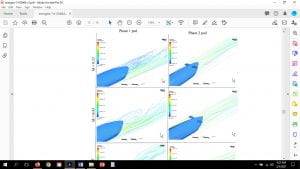Ever since Elon Musk proposed the concept of high-speed transportation using Hyperloop in 2013*, the efficient form for short-haul travel has been studied and modeled in the Mechanical Engineering department at San Jose State. The Hyperloop is a concept for the high-speed ground transportation of passengers traveling in pods at transonic speeds in a partially evacuated tube. It consists of a low-pressure tube with capsules traveling at both low and high speeds throughout the length of the tube.
The benefits of Hyperloop are immediately apparent: as an example, to travel from San Francisco to Los Angeles, a typical aircraft’s gate-to-gate travel time is one hour and 28 minutes, but the actual flight time is only 58 minutes while the remaining 30 minutes are taken up with taxiing, take off, landing, and arrival at the gate. Hyperloop pods could alleviate some of these inefficiencies by traveling in near-vacuum conditions, allowing them to maintain much higher speeds.
However, when a high-speed system travels through a low-pressure tube with a constrained diameter, such as in the case of the Hyperloop, it becomes an aerodynamically challenging problem. Airflow tends to get choked at the constrained areas around the pod, creating a high-pressure region at the front of the pod, a phenomenon referred to as the “piston effect.”
Mechanical Engineering Associate Professor Vimal Viswanathan and graduate student Aditya Bose just published their paper, “Mitigating the Piston Effect in High-Speed Hyperloop
Transportation: A Study on the Use of Aerofoils,” in the journal Energies 2021, 14, 464.

Comparison of the stream lines around the two pods. The phase 2 pod (with fins) led to fewer eddy currents compared to the phase 1 pod.
Papers exploring potential solutions for the piston effect are scarce. The SJSU team studied the aerodynamic performance of a Hyperloop pod inside a vacuum tube, using the Reynolds-Average Navier–Stokes technique for three-dimensional computational analysis. Then they added aerofoil-shaped fins to the aeroshell as a potential way to mitigate the piston effect. The results of their study showed that the addition of fins helps in reducing the drag and eddy currents while providing a positive lift to the pod. Further, these fins were found to be effective in reducing the pressure build-up at the front of the pod.
Viswanathan and Bose had been invited last summer to contribute to this first-ever special issue journal on Hyperloop transportation. “This is only the fourth paper published in English on the aerodynamics of Hyperloop, as well as the first three-dimensional CFD study on the Hyperloop,” said Viswanathan. “We used the Spartan Hyperloop team’s design for the study.”
*Musk, E. Hyperloop Alpha; Spacex: Hawthorne, CA, USA, 2013.